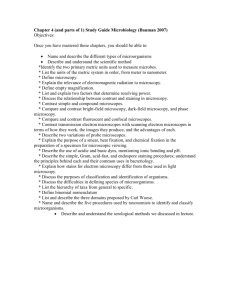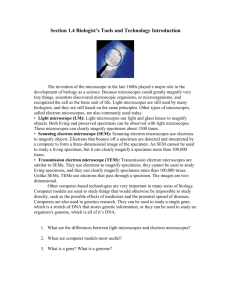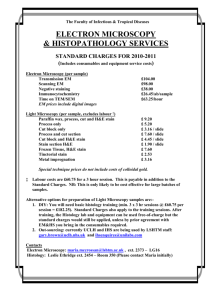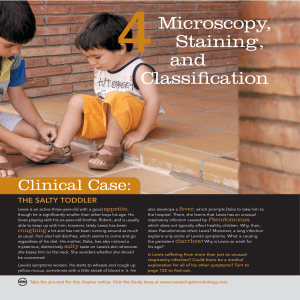Ch 4 Notes
advertisement
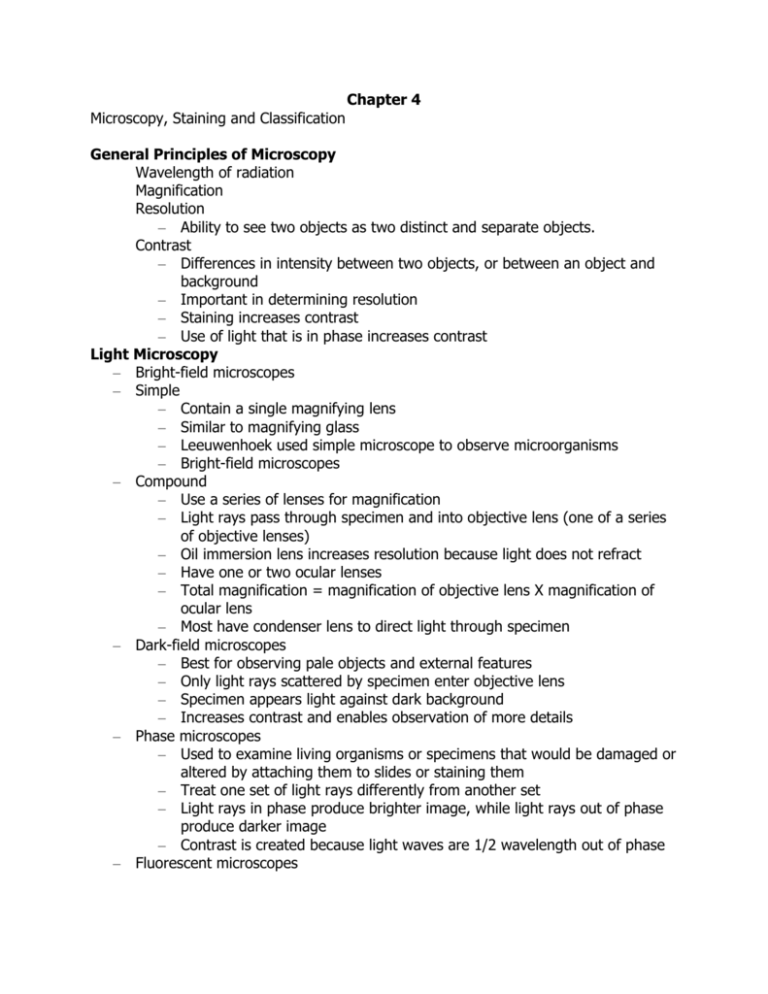
Chapter 4 Microscopy, Staining and Classification General Principles of Microscopy Wavelength of radiation Magnification Resolution – Ability to see two objects as two distinct and separate objects. Contrast – Differences in intensity between two objects, or between an object and background – Important in determining resolution – Staining increases contrast – Use of light that is in phase increases contrast Light Microscopy – Bright-field microscopes – Simple – Contain a single magnifying lens – Similar to magnifying glass – Leeuwenhoek used simple microscope to observe microorganisms – Bright-field microscopes – Compound – Use a series of lenses for magnification – Light rays pass through specimen and into objective lens (one of a series of objective lenses) – Oil immersion lens increases resolution because light does not refract – Have one or two ocular lenses – Total magnification = magnification of objective lens X magnification of ocular lens – Most have condenser lens to direct light through specimen – Dark-field microscopes – Best for observing pale objects and external features – Only light rays scattered by specimen enter objective lens – Specimen appears light against dark background – Increases contrast and enables observation of more details – Phase microscopes – Used to examine living organisms or specimens that would be damaged or altered by attaching them to slides or staining them – Treat one set of light rays differently from another set – Light rays in phase produce brighter image, while light rays out of phase produce darker image – Contrast is created because light waves are 1/2 wavelength out of phase – Fluorescent microscopes Direct UV light source at specimen; causes the specimen to radiate energy back as a longer, visible wavelength – UV light increases resolution and contrast – Some cells and molecules are naturally fluorescent, while others must be stained – Used in immunofluorescence to identify pathogens and to locate and make visible a variety of proteins – Confocal microscopes – Use fluorescent dyes – Use UV lasers to illuminate fluorescent chemicals in a single plane that is no thicker than 1.0 mm – Resolution increased by up to 40% because emitted light passes through pinhole aperture – Computer constructs 3-D image from digitized images – Electron Microscopy • Light microscopes cannot resolve structures closer than 200 nm because shortest wavelength of visible light is 400 nm • Electrons have wavelengths of 0.01 nm to 0.001 nm, so electron microscopes have greater resolving power and greater magnification • Magnifies objects 10,000X to 100,000X • Gives detailed views of bacteria, viruses, internal cellular structures, molecules, and large atoms • Two types – Transmission electron microscopes – Scanning electron microscopes Probe Microscopy • Uses minuscule, pointed, electronic probes to magnify more than 100,000,000 times • Two types – Scanning tunneling microscopes – Atomic force microscopes Staining • Increases contrast and resolution by coloring specimens with stains/dyes • Smear of microorganisms (thin film) air dried to slide and then fixed to surface by heat or chemical fixation • Microbiological stains usually salts composed of cation and anion, with one colored (chromophore) • Acidic dyes stain alkaline structures; more commonly, basic dyes stain acidic structures • Simple stains • • • Differential stains – Gram stain – Acid-fast stain – Endospore stain Special stains – Negative (capsule) stain – Flagellar stain Staining for Electron Microscopy – Chemicals containing heavy metals used for transmission electron microscopy – Stains may bind molecules in specimens or the background Classification & Identification of Microorganisms • Taxonomy consists of classification, nomenclature, and identification • Enables scientists to organize large amounts of information about organisms and make predictions based on knowledge of similar organisms • Linnaeus, Whittaker, and Taxonomic Categories • Linnaeus • Provided system that standardized the naming and classification of organisms based on characteristics in common • Grouped similar organisms that can successfully interbreed into categories called species • Used binomial nomenclature in his system • Whittaker • Linnaeus proposed only two kingdoms • Whittaker proposed a widely accepted taxonomic approach based on five kingdoms: Animalia, Plantae, Fungi, Protista, and Prokaryotae • Linnaeus’s goal was classifying and naming organisms as a means of cataloging them • More modern goal is understanding relationships among groups of organisms • Major goal of modern taxonomy is to reflect phylogenetic hierarchy • Greater emphasis on comparisons of organisms’ genetic material led to proposal to add domain • Domains • Carl Woese compared nucleotide sequences of rRNA subunits (changes occur rarely) • Proposal of three domains based on three basic types of cells as determined by ribosomal nucleotide sequences • Three Domains: Eukarya, Bacteria, and Archaea • Cells in the three domains also differ with respect to many other characteristics Taxonomic and Identifying Characteristics • Physical characteristics • Biochemical tests • Serological tests • Phage typing • Analysis of nucleic acids
